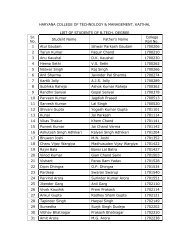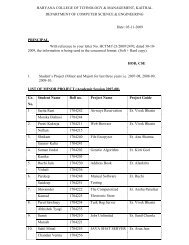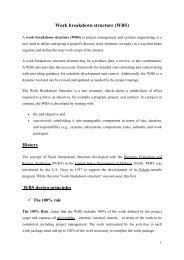Create successful ePaper yourself
Turn your PDF publications into a flip-book with our unique Google optimized e-Paper software.
LECTURE NOTES OF ADVANCED DATA STRUCTURE (MT-CSE 110)<br />
depends on the information that must be stored for each child node and the<br />
size a full disk block or an analogous size in secondary storage. While 2‐3 B‐trees<br />
are easier to explain, practical B‐trees <strong>using</strong> secondary storage want a large<br />
number of child nodes to improve performance.<br />
The term B‐tree may refer to a specific design or it may refer to a general class<br />
of designs. In the narrow sense, a B‐tree stores keys in its internal nodes but<br />
need not store those keys in the records at the leaves. The general class includes<br />
variations such as the B + ‐tree and the B * ‐tree. In the B + ‐tree, copies of the keys<br />
are stored in the internal nodes; the keys and records are stored in leaves; in<br />
addition, a leaf may include a pointer to the next leaf to speed sequential<br />
access [2] . The B * ‐tree balances more neighboring internal nodes to keep the<br />
internal nodes more densely packed [2] . For example, a non‐root node of a B‐tree<br />
must be only half full, but a non‐root node of a B * ‐tree must be two‐thirds full.<br />
Definition<br />
A B‐tree of order m (the maximum number of children for each node) is a tree<br />
which satisfies the following properties:<br />
<strong>1.</strong> Every node has at most m children.<br />
2. Every node (except root and leaves) has at least m ⁄2 children.<br />
3. The root has at least two children if it is not a leaf node.<br />
4. All leaves appear in the same level, and carry information.<br />
5. A non‐leaf node with k children contains k–1 keys.<br />
Each internal node's elements act as separation values which divide its subtrees.<br />
For example, if an internal node has three child nodes (or subtrees) then it must<br />
have two separation values or elements a1 and a2. All values in the leftmost<br />
subtree will be less than a1 , all values in the middle subtree will be between a1<br />
and a2, and all values in the rightmost subtree will be greater than a2.<br />
Prepared By :<br />
Er. Harvinder Singh<br />
Assist Prof., CSE, H.C.T.M (Kaithal) Page ‐ 212 ‐







